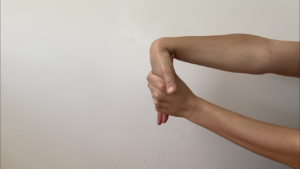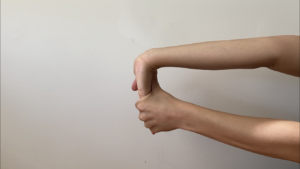Self care for your hands, wrists + forearms
October 20thAs a massage therapist, I am frequently asked if my hands get sore. Whether you’re a manual therapist, frequent computer user, musician, gardener, weight trainer, or athlete, hands and wrists are responsible for so many of our daily movements. They grip, grab, pull and push and are often subjected to a lot of load. Consequently over time our forearms, wrists and hands can hold a lot of tension and/or pain. So yes, they do get sore at times – which is why I’d love to share some of the self-care techniques that help me counteract these repetitive movements.
Understanding forearm and hand tension
There are twenty muscles in our forearms and over thirty in our hands. Many controlling finger movements, wrist flexion, extension and/or lateral deviations. The forearm region is an area prone to overuse as these muscles are shortening and lengthening repetitively over an extended period of time. By listening to your pain, and reinforcing recovery through warming up, stretching, strengthening and self-massage, you can have confidence in your ability to manage this tension until your next treatment.
Warming up – Hand Rolls
Interlace your fingers with your palms facing one another. Rotate your wrists around clockwise, anticlockwise, right, left, and in any direction you find soothing. This is a great way to mobilise the joint and prepare your wrists for stretching.
Mobilisations – Hand Walks
Disclaimer: This stretch can be quite intense however it should not be painful. Listen to your body and exit the stretch if you find yourself pushing too hard.
You can play with the amount of load you place through your hands however it is a warm up exercise so it shouldn’t be too difficult.
- Start in a kneeling position on the floor hands facing forwards
- Pivot your hands outwards at 90 degrees so that your right hand is facing right and left facing left. Pause.
- Walk them another 90 degrees so that both hands are facing you. Pause. Walk them back to starting position pausing at those 90-degree intervals.
- Start turning your hands inwards until they are facing you again, this time we are working through internal rotation. Walk your way back to the starting position and repeat this between 3 and 5 times.
Stretching – Wrist Flexion + Extension
Stretching your wrist flexors and extensors can provide some relief to those achy hands and forearms. Stretches should be executed gently and frequently, aiming for 2-3 sessions a day with 3-5 repetitions of each stretch.
Wrist flexion

- Start with one hand held in front of you, with your palm facing downwards
- Bend the wrist, pointing fingers downwards while the palm is still facing down.
- Assist the stretch with the opposite hand by adding light pressure on your fingers.
- Repeat on the other side.
Wrist extension

- Start with one hand held in front of you, with your palm facing upwards.
- Bend the wrist, pointing fingers downwards while the palm is still facing upwards.
- Assist the stretch with the opposite hand by adding light pressure on your fingers.
- Repeat on the other side.
Self-Massage Techniques
- Ice massage
Ice massage is something I love to use after an especially long day of massaging. Introducing an area to ice should occur after a strenuous activity in order to prevent additional inflammation or re-injury. To give yourself an ice massage, simply place an ice cube in a piece of cloth and lightly massage your forearms, wrists and hands. Keep the ice moving and never keep it still on your bare skin. Wipe off the water that melts. Be thorough and cover the whole area. Do this for no more than 10 minutes. If at any point your wrist becomes numb, remove contact with the ice and introduce some gentle movements until sensation is back to normal.
- Self-massage with trigger ball
Using a massage ball, or any small ball you have available, roll out the muscles of your forearm flexors, extensors and hand. This can assist in counteracting the repetitive movements that cause tension. If you notice any particular areas of tenderness, allow yourself to sink into these trigger points until the sensation mellows down.
Strengthening – First Knuckle Push Up
Implementing some simple strengthening exercises can help reduce the risk of injury to our wrists and hands. One of my favourite exercises is the First Knuckle Push up.
- Start in an all four position on the floor
- Raise the heels of your hands up while leaving the fingers on the floor.
- Push up, pause at the top and lower back down with control.
Spend a little time to send some love to your arms and hands. Adding these simple tips to a self-care regimen can not only address achy pains associated with daily repetitive movements but prevent injuries in the future. If your pain is unusual, doesn’t resolve or worsens, seek advice from a health care professional. Myself and the friendly team at Kinematics are always here to help!
By Danielle Sapiano
Remedial Massage Therapist
We cannot wait to have Danielle back treating at K2 from Tuesday 26th of October on Tuesdays, Thursdays and Saturdays.
